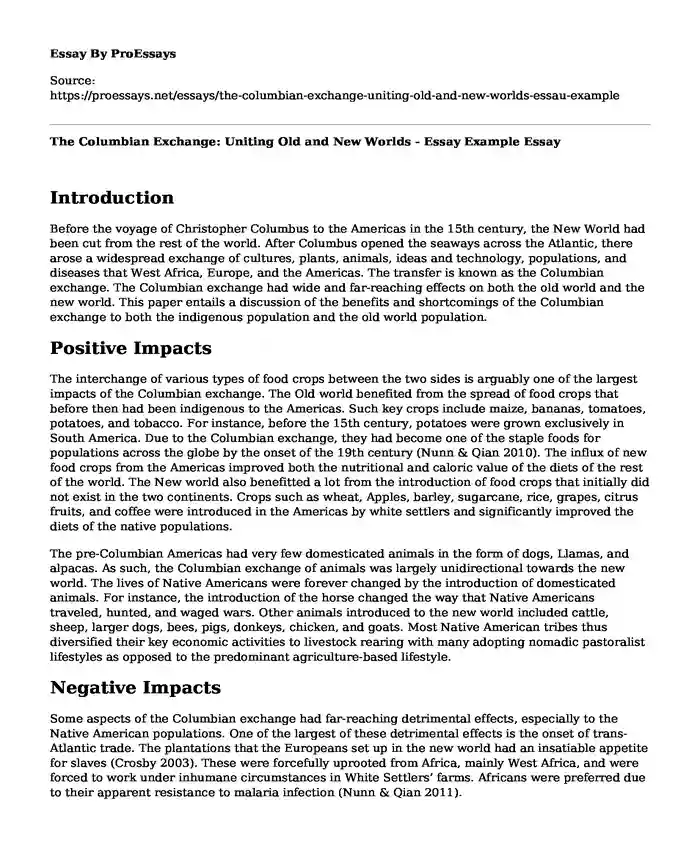Introduction
Before the voyage of Christopher Columbus to the Americas in the 15th century, the New World had been cut from the rest of the world. After Columbus opened the seaways across the Atlantic, there arose a widespread exchange of cultures, plants, animals, ideas and technology, populations, and diseases that West Africa, Europe, and the Americas. The transfer is known as the Columbian exchange. The Columbian exchange had wide and far-reaching effects on both the old world and the new world. This paper entails a discussion of the benefits and shortcomings of the Columbian exchange to both the indigenous population and the old world population.
Positive Impacts
The interchange of various types of food crops between the two sides is arguably one of the largest impacts of the Columbian exchange. The Old world benefited from the spread of food crops that before then had been indigenous to the Americas. Such key crops include maize, bananas, tomatoes, potatoes, and tobacco. For instance, before the 15th century, potatoes were grown exclusively in South America. Due to the Columbian exchange, they had become one of the staple foods for populations across the globe by the onset of the 19th century (Nunn & Qian 2010). The influx of new food crops from the Americas improved both the nutritional and caloric value of the diets of the rest of the world. The New world also benefitted a lot from the introduction of food crops that initially did not exist in the two continents. Crops such as wheat, Apples, barley, sugarcane, rice, grapes, citrus fruits, and coffee were introduced in the Americas by white settlers and significantly improved the diets of the native populations.
The pre-Columbian Americas had very few domesticated animals in the form of dogs, Llamas, and alpacas. As such, the Columbian exchange of animals was largely unidirectional towards the new world. The lives of Native Americans were forever changed by the introduction of domesticated animals. For instance, the introduction of the horse changed the way that Native Americans traveled, hunted, and waged wars. Other animals introduced to the new world included cattle, sheep, larger dogs, bees, pigs, donkeys, chicken, and goats. Most Native American tribes thus diversified their key economic activities to livestock rearing with many adopting nomadic pastoralist lifestyles as opposed to the predominant agriculture-based lifestyle.
Negative Impacts
Some aspects of the Columbian exchange had far-reaching detrimental effects, especially to the Native American populations. One of the largest of these detrimental effects is the onset of trans-Atlantic trade. The plantations that the Europeans set up in the new world had an insatiable appetite for slaves (Crosby 2003). These were forcefully uprooted from Africa, mainly West Africa, and were forced to work under inhumane circumstances in White Settlers’ farms. Africans were preferred due to their apparent resistance to malaria infection (Nunn & Qian 2011).
Before Columbus opened the sea route to the Americas, infectious diseases were significantly less in the new world than in the old world. Most inhabitants of the old world had developed some forms of immunity to disease-causing pathogens due to their endemic status. The physiology of Native Americans, however, had no natural immunity to diseases that they had never encountered (Crosby 2003). As such, the diseases that were brought to the new world by people and animals had a devastating effect on the Native American populations. Diseases such as measles and smallpox wreaked havoc among the Native Americans. It is estimated that smallpox killed more Native Americans than all the wars in the continent combined. Nunn & Qian (2010) posit that around 95% of the Native American population was decimated by pandemics caused by imported diseases such as smallpox and measles in the 100 years proceeding 1492. However, an exploration into native herbs yielded quinine, which was instrumental to the development of the first effective management of malaria.
Conclusion
The Europeans landed on the shores of the new world looking to expand their empires and greatly disrupted social and cultural order of the Native Americans. Naturally, some Native Americans resisted and wars ensued. Most of the Native Americans who were not wiped to be diseases succumbed to ruthless wars that were waged by Europeans because they were better armed.
References
Crosby, W. Alfred. The Columbian Exchange: Biological and Cultural Consequences of 1492. Greenwood Publishing Group, 2003.
Nunn, Nathan. & Qian, Nancy. "The Columbian Exchange: A History of Disease, Food, and Ideas". Journal of Economic Perspectives, vol. 24, no. 2, 2010, pp. 163–188.
Nunn, Nathan. & Qian, Nancy. "The Potato's Contribution to Population and Urbanization: Evidence from a Historical Experiment". Quarterly Journal of Economics, vol. 13, no. 2, 2011, pp. 593–650.
Cite this page
The Columbian Exchange: Uniting Old and New Worlds - Essay Example. (2023, Nov 16). Retrieved from https://proessays.net/essays/the-columbian-exchange-uniting-old-and-new-worlds-essau-example
If you are the original author of this essay and no longer wish to have it published on the ProEssays website, please click below to request its removal:
- The Battle of Gettysburg Essay Example
- The Campaigns of Alexander the Great - Paper Example
- Essay Sample on Slavery in America: The Removal of 6-7 Million Slaves
- Greek Revival Architecture: A Glimpse of Ancient Times - Essay Sample
- Plato's Symposium: A Journal Entry on Ancient Greek Love & Philosophy - Essay Sample
- Essay Example on 1619: The Start of Slavery in Virginia: Inferiority and Racism
- Tim Cook: Journey from Auburn University to Apple CEO - Biography Sample







